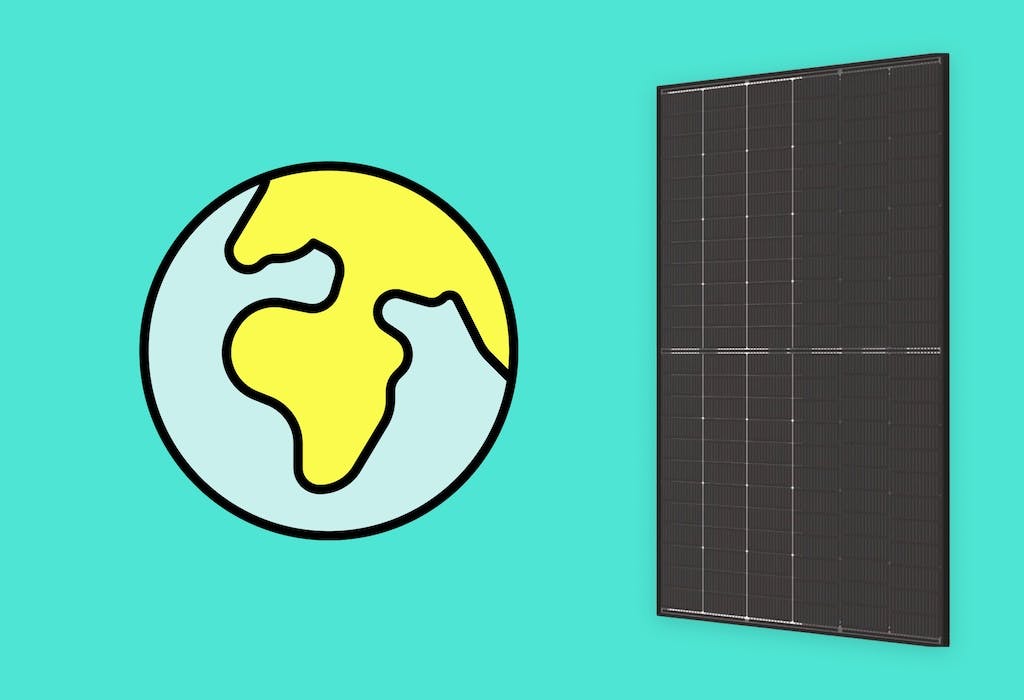- Solar advice hub
- Solar-energy
- The 9 largest solar farms in the world
The 9 largest solar farms in the world
Check out the biggest solar farms around the world, from Egypt and the UAE to India and China.


Why you can trust our content
We know that the solar industry is full of misinformation, but we only use reliable sources, including:
- Our experienced solar experts, installers and system designers
- Our own database of solar & battery system designs
- Authoritative bodies like MCS and the UK government




At a glance
Solar farms are crucial in the global shift towards sustainable energy. These sprawling facilities, which can cover hundreds or even thousands of acres, harness the power of the sun to produce electricity on a massive scale.
By capturing sunlight and converting it into usable energy, solar farms provide a reliable and environmentally friendly alternative to traditional fossil fuels - especially for countries that have historically been heavily reliant on them.
What are the world’s largest solar farms?
The world’s largest solar farms represent remarkable feats of engineering and a significant commitment to renewable energy. These vast installations not only generate substantial amounts of clean electricity but also set benchmarks for future solar projects.
Keep reading as we explore the nine largest solar farms around the world, measured in terms of their generation capacity (in megawatts, or MW). We also highlight their unique features and contributions to their local communities (data sourced from Statista, 2023).
9. Kurnool Ultra Mega Solar Park
| Creator | Country | Year founded | Area (km²) | Size (MW) |
|---|---|---|---|---|
| Andhra Pradesh Solar Power Corporation Private Limited (APSPCL) | India | 2017 | 24 | 1,000 |
The Kurnool Ultra Mega Solar Park, located in Andhra Pradesh, southern India, is the ninth-largest solar park in the world, spread out across 24km² of arid land.
Originally commissioned in 2017 with 350MW capacity, it eventually reached its current capacity of 1,000MW in 2022, enough to power around 750,000 homes.
Kurnool stands out for how quickly the solar park was developed - the project completed in just two years, showcasing India's commitment to renewable energy.
8. Jichuan Solar Park
| Creator | Country | Year founded | Area (km²) | Size (MW) |
|---|---|---|---|---|
| Jinchuan Group & JinkoSolar Holding | China | 2013 | 90 | 1,030 |
The Jinchuan Solar Park in China's Gansu Province is a major player in global solar energy. According to Energy Digital (2023), most of the Jinchuan District is covered in solar panels.
Commissioned in 2013, this expansive solar park stretches across almost 90km² of semi-desert and boasts a capacity of approximately 1,030 MW from 15 separate solar power plants, generating enough electricity for over 876,000 local homes.
7. Noor Abu Dhabi
| Creator | Country | Year founded | Area (km²) | Size (MW) |
|---|---|---|---|---|
| Sweihan PV Power Company | United Arab Emirates | 2019 | 8 | 1,177 |
The Noor Abu Dhabi solar farm, situated in the Sweihan region of the UAE, is the largest single-site solar project in the world. Commissioned in 2019, it spans 8km² and boasts a capacity of 1,177 MW, capable of powering 90,000 homes.
In 2020, the development consortium behind Noor Abu Dhabi broke records with its lowest-ever electricity tariff, achieved through an innovative bidding process that set a new benchmark for solar energy prices worldwide.
To keep the panels clean in their dusty desert location, the solar farm has 1,430 waterless robots that travel over 800 kilometres per day to clean the 3.3 million onsite solar panels.
6. Tengger Desert Solar Park
| Creator | Country | Year founded | Area (km²) | Size (MW) |
|---|---|---|---|---|
| State Grid Corporation of China | China | 2017 | 43 | 1,547 |
The Tengger Desert Solar Park, located at the edge of the Gobi Desert in China's Ningxia region, is the world's sixth-largest solar park. The solar park is often referred to as the "Great Wall of Solar" because it covers 1,200km of the Tengger desert landscape.
Commissioned in 2017, the solar park has an installed capacity of 1,547MW, powering around 600,000 Chinese homes. With its advanced solar technology and resilience to extreme weather, this solar park stands out for its capacity to thrive in the harsh, arid conditions of the Tengger Desert.
In 2018, Tengger Desert Solar Park was the largest solar park in the world, but it has since been overtaken.

5. Mohammed Bin Rashid Al Maktoum Solar Park
| Creator | Country | Year founded | Area (km²) | Size (MW) |
|---|---|---|---|---|
| Dubai Electricity and Water Authority (DEWA) | United Arab Emirates | 2013 | 77 | 1,630 |
The Mohammed Bin Rashid Al Maktoum Solar Park, located in Dubai, UAE, is the fifth-largest renewable energy project in the world. This solar park, named after the Emirate's ruler, is a crucial part of Dubai's Clean Energy Strategy 2050 to generate 75% of Dubai's energy from clean sources.
With a phased commissioning that started in 2013, the solar park features state-of-the-art solar technologies, including concentrated solar power (CSP) systems, battery storage and the world's tallest solar tower, at 260 metres.
The fourth and fifth phases of the project have since added another 1,800MW of capacity, with the aim of achieving a capacity of 5,000MW by 2030.
4. Benban Solar Park
| Creator | Country | Year founded | Area (km²) | Size (MW) |
|---|---|---|---|---|
| New and Renewable Energy Authority (NREA) | Egypt | 2019 | 37 | 1,770 |
The Benban Solar Park, located in Egypt's Aswan Governorate, is Africa's largest solar park and fourth-largest in the world, with the potential to power over one million Egyptian homes.
Benban Solar Park spans over 37km² and originally comprised 32 separate solar plants - however, the number of solar power plants has since grown to 41.
Commissioned in 2019, Benban is a key component of Egypt's ambitious plan to generate 42% of its electricity from renewable sources, with a 22% solar share, by 2030.
3. Pavagada Solar Park
| Creator | Country | Year founded | Area (km²) | Size (MW) |
|---|---|---|---|---|
| Karnataka Solar Power Development Corporation Ltd. (KSPDCL) | India | 2018 | 53 | 2,050 |
Commissioned in 2018, the Pavagada Solar Park (also known as Shakti Sthala Solar Park) is a vital part of India's renewable energy strategy. The solar park is the second-largest installation in India after Bhadla (see 2nd place) and the entire project covers five villages across an area of 53km².
A unique feature of Pavagada is its innovative land-leasing model. Here, the Indian government leases land from at least 2,300 local farmers, providing them with a stable income and fostering community support.
This is significant because the Karnataka region is facing increasing drought and agricultural issues. By making the area a sustainable energy hub, the project has brought the local economy back to life and given thousands of farmers a dependable source of income.
2. Bhadla Solar Park
| Creator | Country | Year founded | Area (km²) | Size (MW) |
|---|---|---|---|---|
| NTPC Renewable Energy Ltd. (NTPCREL) | India | 2017 | 56 | 2,700 |
The Bhadla Solar Park, located in Rajasthan, northeastern India, is India's largest solar park and the world's second-largest solar park, covering over 14,000 acres with a total capacity of 2,700MW.
Commissioned in phases starting in 2015, Bhadla makes good use of the intense solar radiation, low rainfall and vast landscape of the Thar Desert - all of which make it unlivable for humans but an ideal location for solar electricity generation.
One of its unique features is the use of efficient solar technology and energy management systems, like large-scale battery storage, which have set benchmarks for low-cost solar power production worldwide.
1. Golmud Solar Park
| Creator | Country | Year founded | Area (km²) | Size (MW) |
|---|---|---|---|---|
| SDIC Huajing Power Holdings | China | 2019 | 2.6 | 2,800 |
The Golmud Solar Park in China’s Qinghai Province showcases the country's renewable energy progress - the park is part of the larger Qinghai Solar-Thermal Comprehensive Utilization Demonstration Project, aimed at integrating various solar technologies to optimise energy output.
Commissioned in 2019, Golmud comprises 80 separate solar plants with over 7.2 million solar panels providing a collective capacity of around 2,800MW, making it the world's largest solar park as of May 2023.
Golmud's high altitude on the Tibetan Plateau creates ideal conditions for solar panel efficiency with its excellent solar exposure and cooler temperatures.
Summary
From India's Kurnool Ultra Mega Solar Park to China's Golmud Solar Park, the world's largest solar farms are prime examples of the green energy revolution, transforming underused landscapes into hotspots of sustainable power.
It’s vital that the number of solar farms continues to grow globally each year, powering millions more homes and driving global efforts towards a greener future.
The world’s largest solar farms: FAQs
Related articles

The 7 largest solar farms in the UK
Solar farms have exploded in popularity in recent years to meet an increasing demand for electricity. Here are the biggest.

Which countries use the most solar energy?
Our rundown of the countries around the world using the most solar energy, from Mexico to China.

The top 19 solar energy statistics
Here’s the state of the solar industry, through all the most important solar energy statistics for the UK and the world.

17 facts about solar panels
Solar energy is now the cheapest source of electricity in history, thanks to costs falling a whopping 70% in the last 10 years.

Written byMelody Abeni
Based in London, Melody is a specialist green technology writer who has been covering sustainability, climate action and ESG for the past five years, after gathering operational experience in green investing and financial services. She has written for various industry publications, including renewable technology advisor The Eco Experts, and she holds a Master’s degree in law from Birkbeck University.